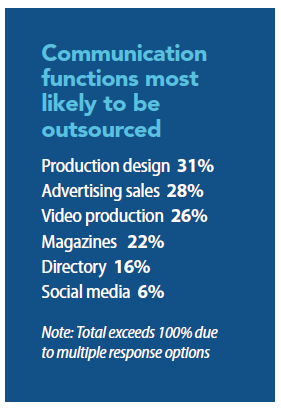Segmenting Members Leads to More Relevant Communications – and More Memberships
Part 6 of our 2017 Association Communications Benchmarking Study series
Last year’s survey results revealed that associations are communicating with members more frequently and via more channels than at any time since we began this survey in 2011. On average, associations communicate with members an estimated 31 times per month (via print, online, social media and video) vs. 30 times per month in 2016 and 26 times per month in 2015.
All of these communications must be created and distributed by someone, and that “someone” is often a member of an association publishing/content creation team who feels overwhelmed by the amount of work they’re expected to do. Just two percent of people surveyed think their association is overstaffed. Forty-seven percent of respondents said their staff has the right amount of people, while 51 percent said they feel understaffed. When asked how they would spend a hypothetical 50 percent increase in budget, more than half said they would invest in hiring more staff.

In a sense, many already hire more staff as needed. These multiple-hat employees sometimes have help in the form of freelancers or agencies. About one-third of respondents said they outsource production design, while about a quarter of respondents said they outsource their advertising sales and/or video production. Other outsourced communication functions include magazines, directories and social media.
How can associations communicate more effectively with the resources they already have and expect to have for the near future?
One answer is to focus on segmenting their member data and create customized communications that reach those segments with a more personal, relevant message.
Customizing member communications isn’t a new idea, and many association professionals already do: More than three out of five of our survey’s respondents said they customize communications for new members, and almost half create specially targeted content for young professionals.
On the flip side, though, less than 60 percent of respondents said they customize communications for any other member segment.
Why segment your member communications?
Segmenting member communications maximizes their relevancy to as many individual members or member groups as possible. Your members have different interests and needs based on their career stage, their job role, their education level and their professional goals. They participate in your association in different ways. The messages they receive from your association should match their way of participating.
“We have real estate members who own or manage buildings, and vendor members who supply products and services that help those building owners and managers work more effectively,” said Tracy White, marketing communications and membership coordinator for BOMA Dallas. “We host several events throughout the year that our real estate members attend and our vendor members sponsor. It wouldn’t be appropriate to send a sponsorship request to the real estate members, so we keep careful lists of the two groups so that we can ensure we are sending the appropriate messages about our programming to the right people.”
The possible ways of segmenting members are numerous:
- Years in industry
- Job role
- For-profit/non-profit affiliation
- Committee membership
- Student status
- Certification level
- Chapter affiliation
- Board member/Board alumnus(a) membership
Segmented communications can be more efficient
One tool that can help associations more efficiently facilitate the segmentation of member communications is association management software (AMS). A clean, updated and organized AMS will have member lists ready to use in addition to the ability to create new lists based on any database field. Deployed in conjunction with communication tools such as a marketing automation platform or an email platform, an AMS can save association staffs time by automatically sending administrative messages as needed.
For example, if members have the ability to register for an event online and those registrations are automatically recorded in the association’s AMS, the event registration can trigger a confirmation email to be sent to the member, confirming their seat at the event as well as their payment.
“We save a lot of time each year during our membership renewal period by using our AMS in conjunction with our email program to send automated emails to members that ask them to renew their membership,” White said. “Our AMS can see who hasn’t yet renewed their membership and send them automatic email reminders that include an online payment link.
“This past spring, we saw an unusual number of members renewing online, without any of our staff having to be actively involved in the messaging or payment process. This allowed us to focus on our spring events and programming more,” she continued.
Whatever tools you use for member communications, consider how they can help you appropriately segment your membership into smaller, more customizable groups. Segmenting members allows you to extend your reach and make your message more relevant.

